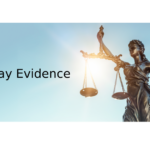That’s Hearsay So It’s Defamation! Explaining the Difference

The terms ‘hearsay’ and ‘defamation’ are often conflated by the general public, despite referring to very different legal principles.
The ordinary meaning of ‘hearsay’ is information received from others which is not substantiated. In the legal context, it refers to evidence received from another person that the other person observed.
In contrast, ‘defamation‘ – whether it be civil defamation or criminal defamation – is a cause of action taken out for a damaging information said or published about a person.
The confusion can arise as a result of the fact that information that is categorised as hearsay may amount to defamation if it is untrue and causes reputational and/or economic damage to its target.
This article seeks to explain the distinction and clear the confusion.
Hearsay evidence in Australian courts
In legalese, hearsay evidence refers to a previous representation made by a person being admitted as evidence to prove the existence of a fact that it can reasonably be supposed that the person intended to assert by the representation.
Breaking this down into separate elements, it involves:
- Person A making a representation (saying something) to Person B; and
- Person B giving evidence in court about what was said by Person A; and
- This evidence being admitted in court to prove that what was said by Person A was true.
The hearsay rule is contained in section 59 of the Evidence Act 1995 which states:
Evidence of a previous representation made by a person is not admissible to prove the existence of a fact that it can reasonably be supposed that the person intended to assert by the representation.
The Act defines a ‘representation’ as including:
- an express or implied representation (whether oral or in writing); or
- a representation to be inferred from conduct; or
- a representation not intended by its maker to be communicated to or seen by another person; or
- a representation that for any reason is not communicated.
This provides a general ban against the use of hearsay evidence in Australian courts.
Exceptions to the hearsay rule
There are a number of exceptions to the hearsay rule under the Evidence Act 1995, which would allow Person B to give hearsay evidence about what Person A said. Some of these exceptions are outlined below.
Evidence relevant for non-hearsay purpose (s60)
This provision means that where a piece of hearsay evidence is given for a non-hearsay purpose, the hearsay rule does not apply to that piece of evidence.
For example, a witness may have made a statement before giving evidence in court.
If there is an inconsistency between the statement of the witness and what the witness says in court, the statement may be used to prove the truth of any facts contained in it.
This is also known as a ‘prior inconsistent statement’.
Maker unavailable (s65)
If a person who made a statement is unavailable in criminal proceedings, evidence that would ordinarily be inadmissible under the hearsay rule may be admissible in the following situations:
- If the maker of the statement was under a duty to make the statement, another person who saw, heard or otherwise perceived the statement being made may be able to give evidence.
- If the statement was made shortly after the asserted fact occurred and in circumstances where the asserted fact is unlikely to be false.
- If the statement is made in circumstances that make it highly probable to be reliable.
- If the statement was against the interests of the person who made it at the time that it was made and the circumstances make it likely that the statement was reliable.
Maker available (s66)
If the person who made the statement is available in criminal proceedings, the hearsay rule may be relaxed.
If another person heard, saw or otherwise perceived the representation, and the events are fresh in their memory, then that evidence will be admissible.
Tags and labels (s70)
The hearsay rule does not apply to tags and labels which describe the contents of objects or documents, and which were fixed to them in the course of a business.
Electronic communications (s71)
The hearsay rule does not apply to the identity of the sender, the date and time of the communication and the identity of the person/body to which the communication was sent.
Relationships and age (s73)
In a civil matter, the hearsay rule does not apply to evidence concerning whether a person is, or was at any time, married.
The hearsay rule also does not apply to a person’s age or their family history or family relationship.
In a criminal matter, this exception only applies if the defendant gives reasonable notice to the other parties, or if the evidence would contradict other admitted evidence.
Reputation of public or general rights (s74)
In criminal cases, hearsay evidence in relation to public or general rights can only be admitted by the prosecutor to contradict assertions by the defence.
Evidence in interlocutory proceedings (s75)
If a party can show evidence as to the source of a hearsay statement, this evidence will be admissible in interlocutory proceedings.
Defamation laws in Australia
Defamation is a wrong arising from an attack on reputation, allowing person to sue another for damages (or compensation).
Words are defamatory if they convey a meaning about a person which lowers their reputation in the eyes of reasonable members of the community, or causes the person to be ridiculed, avoided or despised by members of the general public.
Defamation may amount to a civil wrong for which an aggrieved person (the plaintiff) can seek damages against the publisher (the defendant) or, in some circumstances, a criminal offence.
Civil Defamation
To establish a claim of civil defamation, the plaintiff is required to establish ‘on the balance of probabilities’ (ie that it is more likely than not) that:
- The defendant published defamatory material ;
- The publication identified the plaintiff; and
- An ordinary person would consider the material that was published to be defamatory;
- The publication of the defamatory material caused, or was likely to cause, serious harm to the party’s reputation.
The Defamation Act 2005 (NSW) outlines a number of defences available when sued for defamation, which include:
- The defence of justification under section 25 of the Act, which applies when statements made are “substantially true”.
- The defence of absolute privilege under section 27 of the Act, where special allowance is made under law for material to be published. Eg. during parliamentary debates or as part of court proceedings.
- The defence of honest opinion under section 31 of the Act, where communications are an opinion of the defendant, related to a matter of public interest and based on proper material.
Criminal Defamation
Section 529(3) of the Crimes Act 1900 (NSW) is headed ‘Criminal Defamation’ and makes it an criminal offence punishable by a maximum penalty of 3 years in prison for a person, without lawful excuse, to publish a matter that is defamatory of another living person knowing the matter to be false and intending to cause serious harm to that person or any other person, or being reckless as to whether such harm would be caused.
To establish the offence, the prosecution must prove beyond reasonable doubt that:
- You published a matter that was defamatory to another living person,
- You intended by doing so to cause serious harm to that person or to any other person or were reckless as to whether serious harm would be caused,
- You knew the published matter was false, and
- Where there is evidence of a lawful excuse, you did not have a lawful excuse for your conduct.
Subsection 529(4) of the Crimes Act provides that:
A defendant in proceedings for an offence under this section has a lawful excuse for the publication of defamatory matter about the victim if, and only if, the defendant would, having regard only to the circumstances happening before or at the time of the publication, have had a defence for the publication if the victim had brought civil proceedings for defamation against the defendant.
This would include many of the defences outlined for civil defamation above.
Going to court for a criminal offence?
If you are going to court for a criminal offence, call Sydney Criminal Lawyers anytime on 9261 8881 to arrange a free first conference during which one of our experienced defence lawyers will assess the case, advise you of your options and the best way forward, and fight for the optimal outcome.






